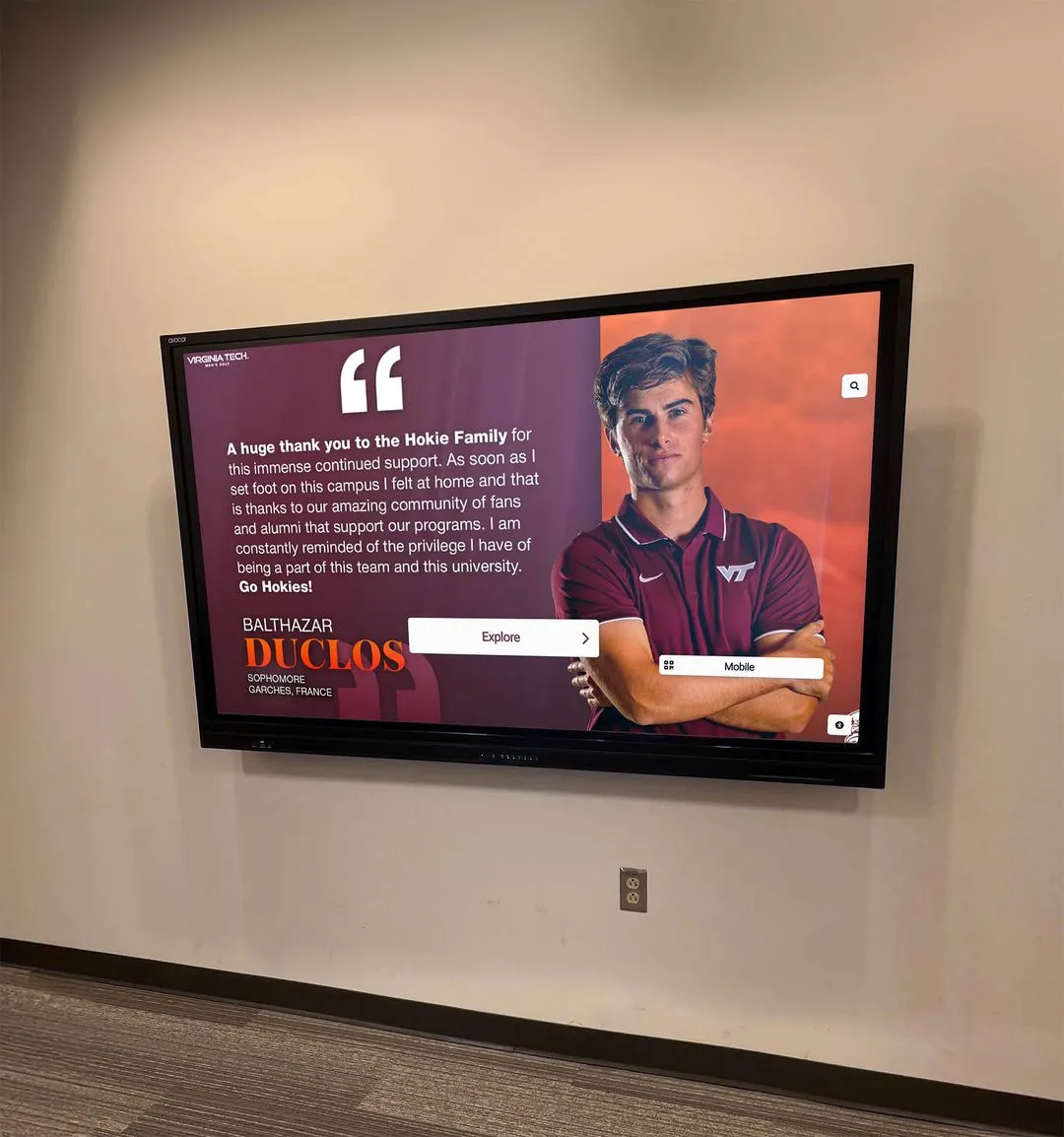Key Takeaways
Comprehensive guide to recognizing student athletes achieving high honors. Learn GPA requirements, recognition program best practices, and modern digital display strategies for celebrating dual excellence in athletics and academics.
Student athletes who excel both on the field and in the classroom represent the highest ideals of educational athletics—demonstrating that competitive excellence and academic achievement are not mutually exclusive but mutually reinforcing. Yet many schools struggle to adequately recognize this dual excellence, often celebrating athletic achievements prominently while academic honors receive only passing mention in newsletters or brief announcements.
This comprehensive guide examines everything schools need to know about implementing effective student athlete high honors recognition programs in 2025. From establishing appropriate GPA thresholds and qualification criteria to implementing modern digital recognition displays that showcase both athletic and academic excellence, this resource provides practical frameworks schools can use to transform student athlete recognition into a powerful culture-building tool that inspires excellence across both domains.
Understanding Student Athlete Academic Recognition
Before implementing recognition programs, schools must understand what student athlete high honors actually means, why it matters for educational mission, and how it contributes to both athletic program culture and broader school academic achievement.
Defining High Honors for Student Athletes
High honors recognition for student athletes acknowledges exceptional academic performance while maintaining demanding athletic commitments. Unlike general academic recognition that focuses solely on GPA, student athlete honors specifically celebrate individuals who succeed in both arenas simultaneously.
Common GPA Thresholds for Student Athlete Recognition:
According to national athletic organizations, the most widely recognized standards include:
Academic All-America: Students must maintain at least a 3.50 cumulative grade point average on a 4.0 scale at their current institution while serving as a starter or important reserve.
Conference Scholar-Athlete Programs: Many high school athletic conferences require minimum grade-point averages of 3.25 for varsity team members to earn scholar-athlete designation.
National High School Coaches Association: This organization recognizes nominees who carry at least a 3.6 grade point average on a 4.0 scale.
State-Level Programs: The NCHSAA Scholar-Athlete Program, for example, requires individual varsity-level scholar-athletes to attain at least a 3.5 weighted GPA for the participating semester.
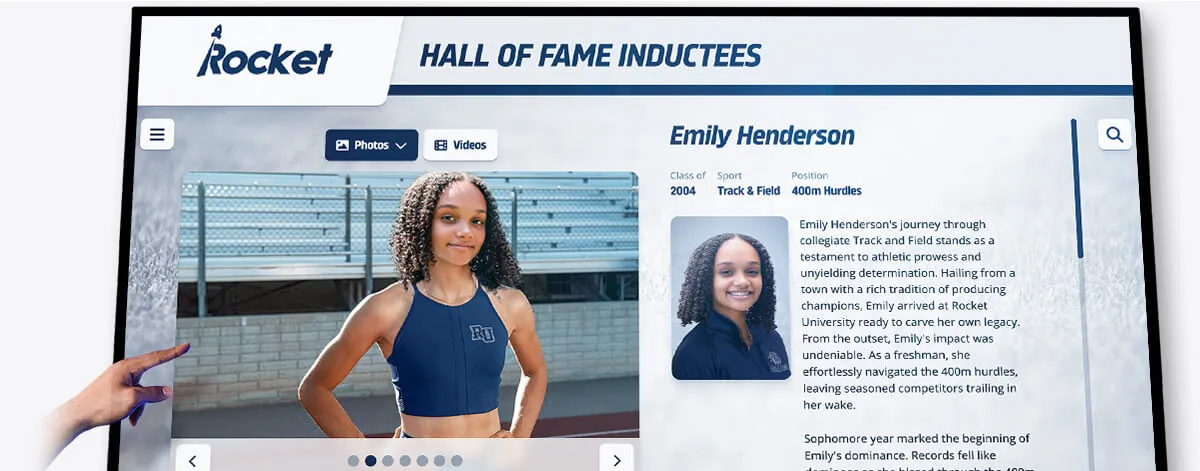
CIF Scholar Athlete Standards: The CIF North Coast Section awards Scholar Athlete Honor Roll status to any varsity athlete who achieves a 3.5-3.79 GPA (unweighted).
Most programs establish 3.5 GPA as the baseline for student athlete high honors recognition, with some requiring 3.6 or higher for more prestigious designations. This threshold acknowledges that maintaining strong academics while dedicating significant time to athletic training, practices, and competitions requires exceptional time management and commitment.
Why Student Athlete Academic Recognition Matters
Recognition programs that celebrate dual excellence serve multiple essential functions within educational athletic programs.
Reinforcing Academics as Priority: When schools prominently recognize academic achievement alongside athletic success, they communicate that classroom performance matters as much as field performance. This messaging proves particularly important in athletic cultures where competitive success can overshadow educational priorities.
Motivating Academic Effort: Clear recognition standards create specific goals student athletes can pursue. When athletes understand that maintaining 3.5 GPA qualifies them for scholar-athlete recognition appearing on digital displays, team rosters, and recognition ceremonies, they have concrete targets beyond vague aspirations to “do well in school.”
Supporting College Recruitment: College coaches and admissions offices increasingly value student athletes demonstrating both athletic talent and academic capability. Recognition as a scholar-athlete with documented high honors achievement strengthens college applications and athletic recruitment profiles significantly.
Building Complete Athletic Identity: Student athlete recognition helps young athletes develop identities as complete individuals rather than solely as competitors. Athletes who receive consistent acknowledgment for scholarly achievement alongside athletic success are more likely to internalize balanced identities that will serve them throughout life, particularly after athletic careers end.
Modeling Priorities for Younger Athletes: When high-achieving student athletes receive prominent recognition for academic excellence, they model attainable success for younger teammates and athletes. This peer influence often motivates academic effort more effectively than adult messaging alone.
Establishing Student Athlete Honor Roll Programs
Effective student athlete honor roll programs require thoughtful design addressing several key decisions specific to athletic contexts.
Setting Appropriate GPA Requirements
The most fundamental decision involves determining GPA thresholds that appropriately recognize academic excellence while accounting for the additional time demands athletic participation creates.
Single Tier vs. Multiple Recognition Levels:
Single High Honors Threshold: Some schools establish one prestigious scholar-athlete designation—typically 3.5 or 3.6 GPA—recognizing all student athletes exceeding that standard equally. This approach emphasizes selectivity and prestige, making recognition particularly meaningful for recipients. However, single-tier programs create limited recognition opportunities and may fail to acknowledge athletes making progress toward higher achievement.
Multiple Recognition Tiers: Many schools implement tiered systems:
- Scholar-Athlete with Highest Honors: 3.7-4.0 GPA
- Scholar-Athlete with High Honors: 3.5-3.699 GPA
- Scholar-Athlete Honorable Mention: 3.25-3.499 GPA
Multiple tiers create more recognition opportunities while maintaining meaningful distinctions between achievement levels. Athletes who narrowly miss top honors still receive acknowledgment rather than complete exclusion, which research suggests maintains motivation more effectively than all-or-nothing systems.
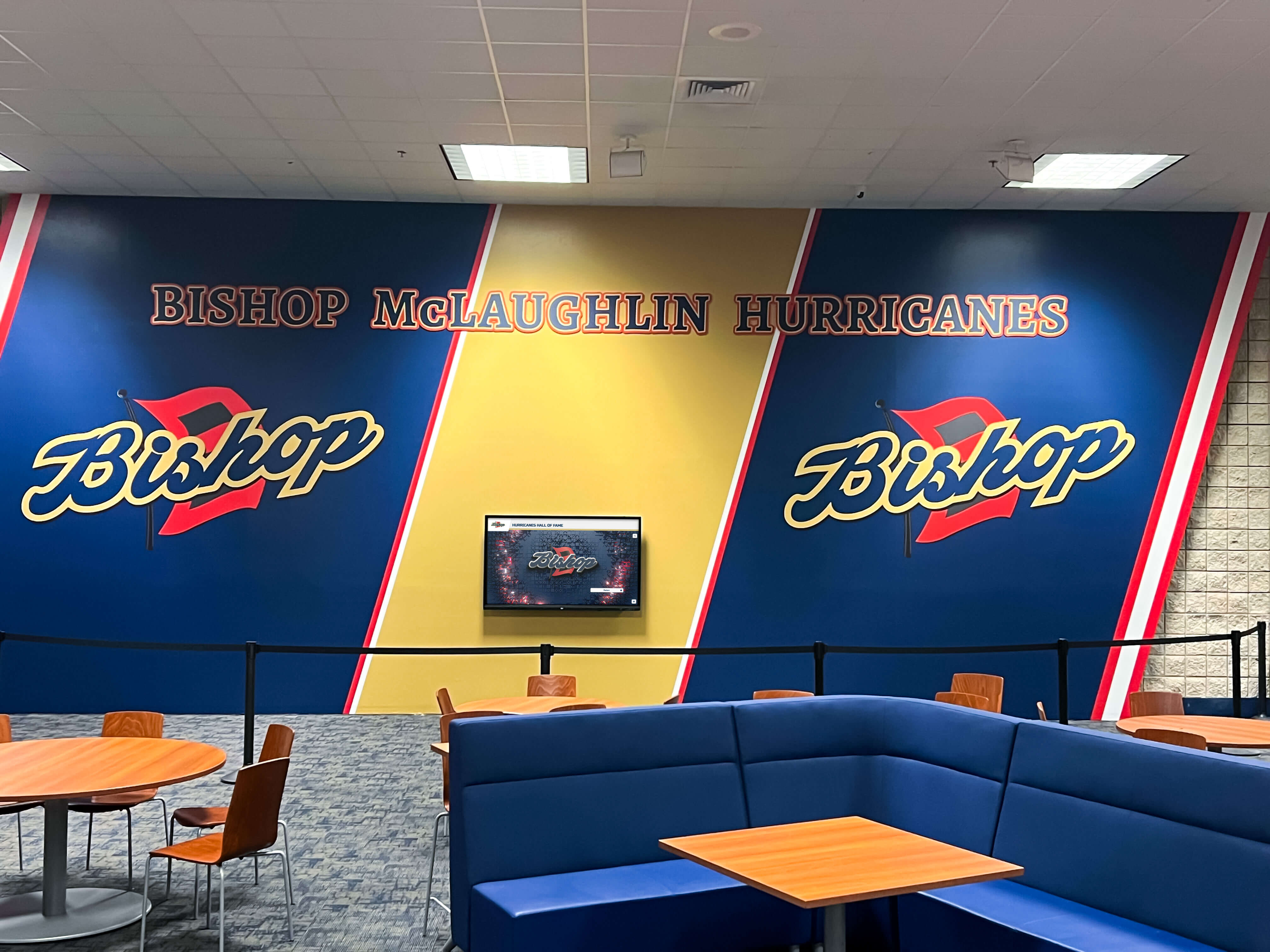
Weighted vs. Unweighted GPA Considerations:
Schools using weighted GPAs that award extra points for advanced, honors, or AP courses face additional decisions. Should scholar-athlete criteria use weighted or unweighted GPAs?
Weighted calculations reward student athletes challenging themselves with rigorous coursework rather than selecting easier classes to maintain high grades—demonstrating genuine academic commitment. However, weighted systems may disadvantage athletes without access to advanced courses due to scheduling constraints created by athletic commitments or prerequisite requirements.
Consider dual recognition approaches acknowledging achievement using both weighted and unweighted calculations, ensuring student athletes in various academic programs have realistic pathways to scholar-athlete recognition.
Participation and Eligibility Requirements
Beyond GPA thresholds, effective programs establish clear participation criteria defining which athletes qualify for academic recognition.
Athletic Participation Standards:
Varsity vs. All Levels: Most programs limit scholar-athlete recognition to varsity participants, acknowledging the higher time commitment and competitive demands varsity athletics require. However, some schools extend recognition to junior varsity athletes, particularly in programs building comprehensive cultures of academic excellence.
Minimum Participation Requirements: Establish clear standards for athletic participation qualifying athletes for recognition:
- Must be on active roster for the season
- Must complete the season (not just join briefly)
- Must participate in minimum percentage of competitions or meet practice attendance thresholds
- Must maintain athletic eligibility throughout the recognition period
These requirements prevent situations where students join teams briefly to qualify for scholar-athlete designation without meaningful athletic commitment.
Multiple Sport Recognition: Clarify whether multi-sport athletes receive separate recognition for each season they qualify or cumulative year-end recognition. Consider special acknowledgment for athletes maintaining high honors across multiple sport seasons, as this demonstrates particularly exceptional time management and dedication.
Timing and Recognition Periods
When schools calculate and announce student athlete honors significantly impacts program effectiveness.
Seasonal Recognition: Most athletic programs recognize scholar-athletes at the conclusion of each sport season, using GPA from the marking period or semester coinciding with that season. Seasonal recognition connects academic achievement directly to specific athletic participation while providing multiple annual recognition opportunities.
Semester Recognition: Some schools prefer semester-based scholar-athlete recognition regardless of sport seasons. This approach simplifies administration but may not connect as directly to specific athletic commitments.
Annual Recognition: Year-end recognition based on cumulative GPA acknowledges sustained excellence throughout entire school years. Annual programs reward consistent achievement but provide limited interim feedback and delayed recognition compared to seasonal approaches.
Most schools find that seasonal recognition for each sport optimally balances administrative workload with meaningful frequency, celebrating dual excellence at natural conclusion points when athletic seasons end and final grades become available.
Creating Comprehensive Recognition Profiles
Moving beyond simple name lists, comprehensive recognition profiles showcase the complete achievements of student athletes earning high honors.
Essential Profile Components
Well-designed student athlete recognition profiles include multiple elements documenting both academic and athletic excellence.
Academic Information:
- Cumulative GPA (specify weighted or unweighted)
- Semester or marking period GPA qualifying for recognition
- Honor roll tier or distinction level
- Academic awards and honors
- Advanced coursework (AP, honors, dual enrollment)
- Academic honor society memberships
- Subject-specific excellence or departmental recognition
Athletic Achievement:
- Sport(s) and position(s)
- Varsity letters earned
- Years of participation
- Athletic honors and awards (All-Conference, All-State, team MVP, etc.)
- Statistical achievements or records
- Leadership roles (team captain, etc.)
- Championships or tournament success
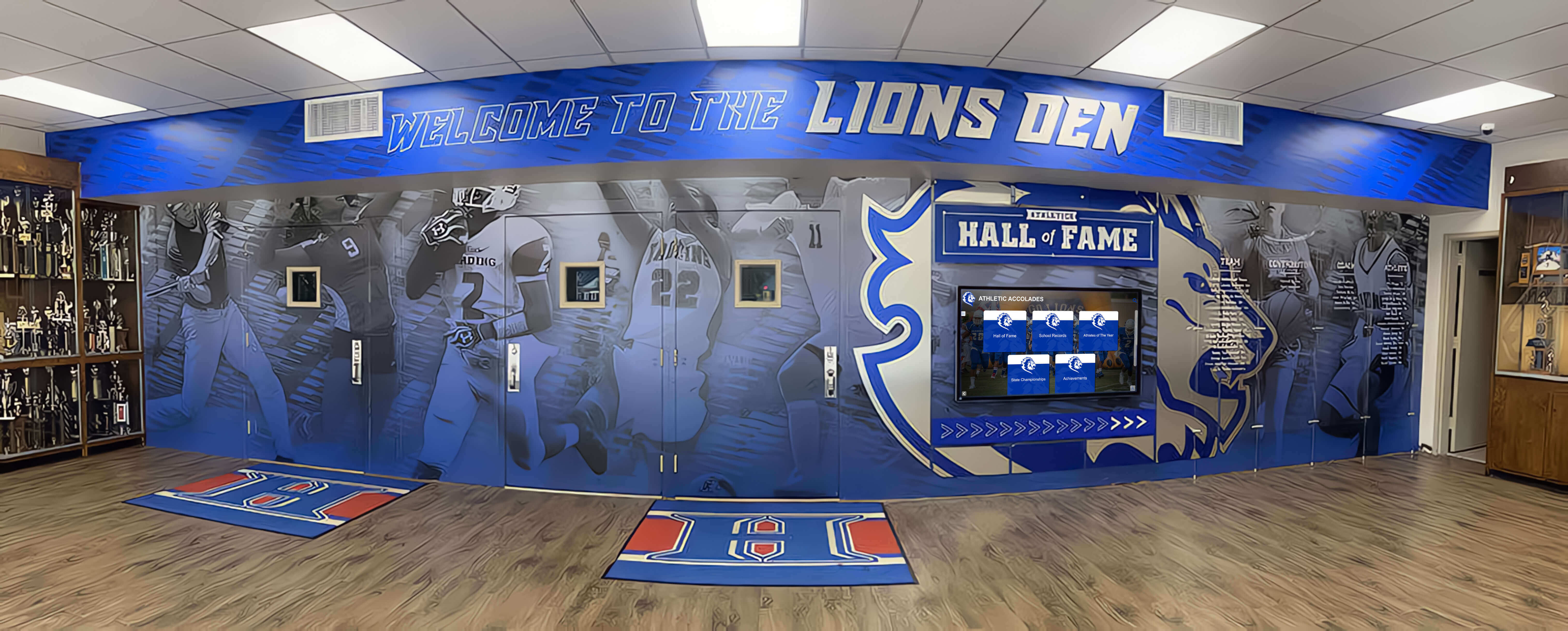
Personal Elements:
- Professional photograph in athletic uniform or formal portrait
- Brief biography or personal statement
- College commitments or athletic recruitment status
- Career aspirations
- Community service or leadership activities
- Motivational quotes or perspective on balancing athletics and academics
Historical Context:
- Recognition history across multiple years
- Progression of achievement over time
- Connection to school or program legacy
- Family athletic heritage if applicable
Comprehensive profiles transform simple recognition into meaningful documentation of exceptional individuals, creating content that honors achievements appropriately while providing role models for current and future student athletes.
Digital vs. Traditional Recognition Formats
Schools must decide how to present and display student athlete recognition profiles effectively.
Traditional Recognition Limitations:
Conventional approaches—bulletin boards with printed certificates, plaques mounted in trophy cases, names in program inserts, brief newsletter mentions—face significant constraints:
- Limited Space: Physical displays accommodate only a small number of profiles before becoming overcrowded or requiring constant rotation that removes older recognition from view
- Static Content: Once printed and mounted, traditional recognition cannot be updated, corrected, or enhanced without replacement
- Minimal Detail: Space constraints typically limit traditional formats to names, sports, and GPAs without room for comprehensive profiles
- Accessibility: Physical displays only reach individuals who physically visit specific school locations
- Maintenance Burden: Updating requires reprinting, remounting, and physical installation work each season
Digital Recognition Advantages:
Interactive digital displays and online platforms address traditional limitations while creating more engaging, comprehensive recognition experiences. Solutions like digital recognition displays designed for schools provide purpose-built platforms specifically for educational and athletic recognition.
Unlimited Capacity: Digital systems eliminate space constraints entirely. A single display can showcase every scholar-athlete profile across all sports and multiple years—content requiring dozens of physical bulletin boards or display cases.
According to digital signage research, 63% of people report that digital signage catches their attention compared to 30% who notice traditional signs. This increased engagement means more students, families, and visitors actually notice and interact with recognition content.
Multimedia Rich Profiles: Digital platforms enable detailed recognition far beyond simple names and statistics:
- Professional athlete photographs
- Video highlights or interviews
- Complete achievement histories
- Interactive elements allowing visitors to explore connections between athletes
- Links to game statistics or season summaries
- Social media integration
Searchable and Interactive: Unlike static displays visitors glance at while passing, interactive recognition displays invite active engagement. Students, families, teammates, and visitors can search by name, browse by sport, filter by graduation year, view related athletes, and explore detailed profiles with complete recognition histories across multiple seasons.
Easy Updates and Management: Digital recognition updates instantly through cloud-based content management that authorized staff can access from any device. After each sport season ends, coaches or athletic directors can update scholar-athlete recognition within minutes rather than hours of manual display updating, printing, and mounting work.
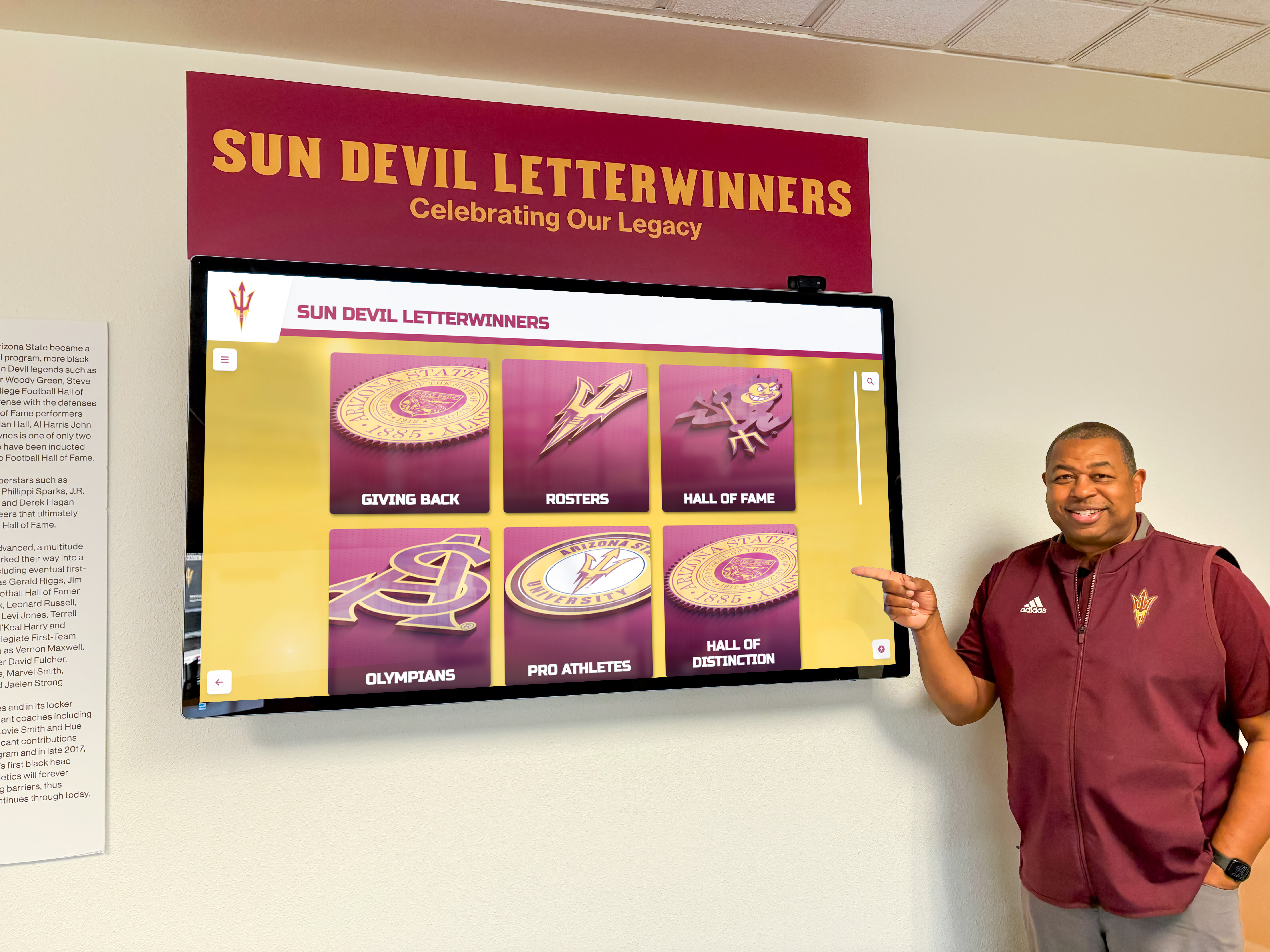
Extended Access: Web-connected digital displays can mirror content online, allowing:
- Athletes to share their recognition profiles on social media
- Distant family members to view achievements remotely
- College coaches to explore athlete academic credentials
- Alumni to find their historical recognition decades later
- Community members to engage with school athletic excellence
Schools implementing comprehensive student recognition programs find that digital platforms significantly extend recognition impact beyond brief ceremony moments, creating permanent, accessible documentation that serves multiple audiences across many years.
Recognition Ceremony and Celebration Best Practices
How schools celebrate student athlete high honors determines whether programs create genuine motivational impact or feel like perfunctory obligations.
Timing Recognition Effectively
Strategic timing maximizes attendance, engagement, and recognition impact.
End-of-Season Celebrations: Recognize scholar-athletes during end-of-season team banquets, award ceremonies, or celebration events when teams, families, and school communities gather to honor athletic achievements. Integrating academic recognition into athletic celebrations reinforces the message that both forms of excellence matter equally.
Academic Award Nights: Some schools hold dedicated academic recognition ceremonies where student athletes receive honors alongside non-athlete scholars. This approach elevates academic achievement while demonstrating that athlete scholars compete at the highest levels academically.
Game Day Recognition: Recognize scholar-athletes during games or competitions through:
- Pre-game announcements and introductions
- Halftime presentations with families on field or court
- Recognition during senior nights or special events
- Display of scholar-athlete designation on roster boards or programs
Multiple Touchpoints: Consider recognizing student athletes through multiple formats rather than relying on single ceremony moments. Announce initially through digital displays and online platforms, present certificates during team events, recognize during games, and maintain permanent digital documentation accessible continuously.
Creating Meaningful Presentation Formats
The format of recognition presentations significantly influences how special athletes and families feel about acknowledgment.
Formal Certificate Presentation: Present professional certificates documenting scholar-athlete achievement including:
- Student athlete name
- Academic marking period or semester
- Specific GPA earned
- Sport and participation details
- School and athletic department seals
- Signatures from principal, athletic director, and coach
Special Recognition Items: Consider tangible items beyond certificates:
- Scholar-athlete medals or pins athletes can wear or display
- Recognition patches for letter jackets or uniforms
- Specialized gear (scholar-athlete t-shirts, hoodies, etc.)
- Recognition plaques for multiple-year achievement
- Academic letter awards parallel to athletic letters
Family Involvement: Create opportunities for families to participate:
- Invitations to attend recognition ceremonies or presentations
- Opportunities for family photos with certificates or at digital displays
- Direct communication acknowledging support role in student success
- Shareable digital content families can post on social media
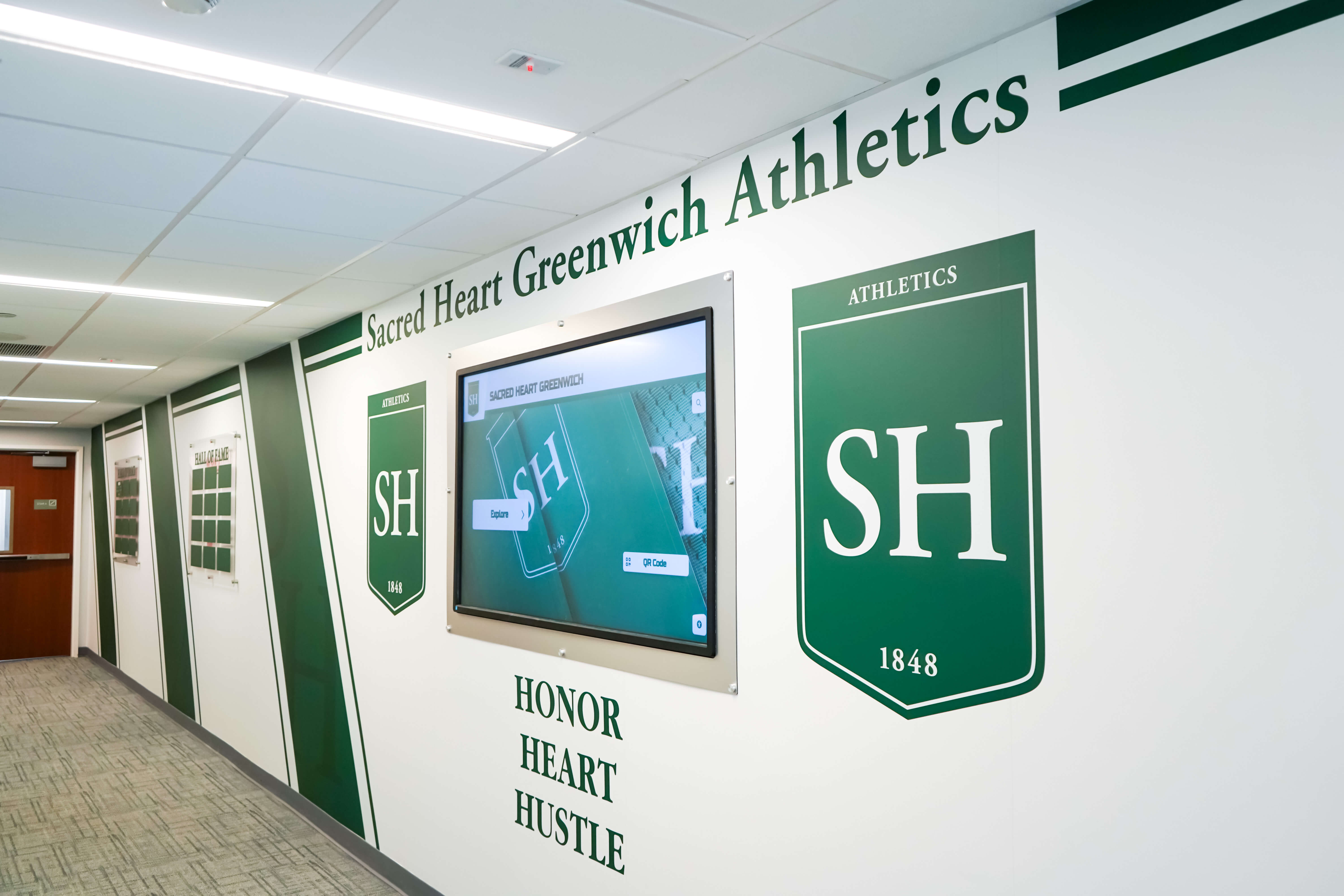
Peer Recognition: Ensure teammates and broader student body know about achievements:
- Announcements during school assemblies or morning programs
- Features in school newspapers or broadcast programs
- Social media posts celebrating individual and team academic success
- Recognition boards visible in athletic facilities where athletes congregate
Building Fair and Inclusive Recognition Systems
Student athlete recognition programs must balance academic standards with athletic participation realities, ensuring all athletes have realistic opportunities for acknowledgment.
Addressing Time Management Challenges
Student athletes face unique scheduling constraints that can impact academic performance despite genuine effort and capability.
Practice and Competition Time Demands: High school student athletes commonly dedicate 10-20 hours weekly to practices, competitions, and athletic-related activities during season. Travel to away competitions adds additional time, sometimes requiring missed school or late-night returns affecting next-day performance.
In-Season vs. Off-Season Recognition: Consider whether recognition criteria account for in-season academic performance specifically rather than only cumulative year-end GPAs. Athletes maintaining high achievement during demanding competitive seasons demonstrate exceptional time management deserving particular recognition.
Accommodation and Support: Schools should ensure student athletes have access to:
- Academic support services and tutoring
- Flexible assignment deadlines for travel-related absences
- Communication between coaches and teachers about scheduling challenges
- Study hall or designated academic time within athletic schedules
Recognition programs work most effectively when paired with support systems helping student athletes achieve academic success despite time demands rather than simply acknowledging those who succeed without support.
Ensuring Equitable Recognition Across Sports
Different sports have different seasonal schedules, time demands, and competitive structures that may affect academic performance patterns.
Seasonal Variations: Fall sport athletes face different academic challenges than spring sport participants. Football players may balance homework during intense fall championship runs, while baseball players navigate end-of-year AP examinations during peak season. Recognition programs should account for these timing variations rather than advantaging certain sports.
Team vs. Individual Sports: Athletes in team sports often face more rigid practice schedules with limited flexibility, while individual sport athletes may have more control over training timing. Both contexts present distinct time management challenges deserving recognition.
Gender Equity: Monitor recognition distribution across male and female athletes, ensuring programs provide equal opportunities and acknowledgment regardless of sport gender composition. If data reveals systematic differences, investigate causes and adjust support or criteria ensuring equity.
Sport Prestige Variations: Avoid allowing school priorities around certain sports (typically football and basketball) to overshadow recognition for student athletes in less prominent sports. Scholar-athletes in golf, tennis, swimming, cross country, and other sports deserve equal celebration regardless of sport popularity or visibility.
Modern Recognition Technology and Display Solutions
Contemporary technology enables schools to recognize student athlete academic excellence more comprehensively, engagingly, and permanently than traditional methods allowed.
Interactive Touchscreen Recognition Displays
Interactive digital displays installed in athletic facilities, main hallways, or school lobbies transform recognition from static acknowledgment into engaging experiences that build community and inspire excellence.
Key Features of Effective Athletic Recognition Displays:
Comprehensive Profile Capability: Modern displays should accommodate detailed scholar-athlete profiles including photos, academic and athletic statistics, achievement histories, and biographical information—creating meaningful documentation beyond simple name lists.
Intuitive Navigation: Athletic directors, coaches, students, and visitors should be able to easily browse or search for specific athletes, filter by sport or graduation year, and explore related content without technical expertise or training.
Easy Content Management: Cloud-based management systems allow authorized staff to update recognition content from any device without IT department involvement. After each season concludes, coaches can add new scholar-athlete profiles, update existing records, or make corrections within minutes.
Dual Academic and Athletic Focus: Effective displays integrate both academic honors and athletic achievements, showcasing scholar-athlete profiles alongside team records, championship documentation, hall of fame inductees, and other athletic recognition. This integration reinforces that academic and athletic excellence are complementary rather than separate.
Historical Archives: Quality systems maintain searchable archives documenting scholar-athlete recognition across decades. These archives preserve institutional memory, allow alumni to find their historical achievements, and demonstrate program commitment to academic excellence over time.
Platforms like touchscreen software designed for school recognition provide purpose-built solutions specifically for educational athletic contexts, offering intuitive interfaces and proven approaches that help schools build recognition cultures their student athletes deserve.
Web-Based Recognition Platforms
Complement physical displays with web-accessible content extending scholar-athlete recognition beyond those who can physically visit school facilities.
Dedicated Web Pages: Create website sections specifically for scholar-athlete recognition featuring:
- Current season scholar-athlete lists for all sports
- Searchable athlete profile directories
- Historical archives of previous recognition
- Explanation of program criteria and standards
- Photo galleries celebrating dual excellence
- Statistics and trends tracking program growth over time
Virtual Access Benefits: Web-based recognition proves particularly valuable for:
- College coaches researching recruited athletes’ academic credentials
- Distant family members celebrating student achievements
- Alumni exploring their historical scholar-athlete recognition
- Community members supporting educational athletics
- Prospective students and families researching school culture
- Media covering local athletic programs
Social Media Integration: Strategic social media use amplifies student athlete recognition beyond campus while creating shareable content engaging broader communities.
Create dedicated posts celebrating individual scholar-athletes with photos and achievement descriptions. Individual posts give each honoree dedicated visibility and shareable content for their families. When posting on public social platforms, always obtain appropriate permissions following district policies regarding student privacy and photo releases.
Many schools implementing weekly top performers and athlete recognition programs find that combining physical displays, web platforms, and social media creates comprehensive recognition ecosystems that maximize engagement and impact across multiple audience segments.
Program Administration and Implementation
Schools ready to launch or significantly improve student athlete high honors recognition programs should follow systematic planning ensuring successful implementation.
Establishing Clear Program Guidelines
Committee Formation: Assemble planning team including:
- Athletic director providing program leadership
- Coaches representing different sports and seasons
- Academic administrators ensuring alignment with school standards
- Counselors understanding student needs and achievement patterns
- Technology coordinators supporting digital implementation
- Student athlete representatives offering participant perspective
Criteria Documentation: Create written program guidelines specifying:
- GPA thresholds for each recognition tier
- Calculation methods (weighted vs. unweighted)
- Athletic participation requirements
- Eligibility and timing details
- Application or nomination processes if applicable
- Handling of special circumstances (transfers, injuries, etc.)
- Appeal or review procedures for borderline cases
Communication Strategy: Develop comprehensive communication plan:
- Explain program criteria to athletes, families, and coaches at season start
- Provide regular updates about current standing relative to scholar-athlete thresholds
- Communicate recognition results promptly when determined
- Maintain transparency about program goals, criteria, and processes
Technology Selection and Implementation
Schools implementing digital recognition displays should evaluate options based on specific athletic program needs.
Display Hardware Considerations:
- Screen size appropriate for viewing distance and location
- Touchscreen capability enabling interactive exploration
- Durability suitable for athletic facility environments
- Professional appearance reflecting school pride and quality
- Integration with existing school network infrastructure
Software Platform Requirements:
- Purpose-built for educational athletic recognition rather than generic digital signage
- Intuitive content management requiring no technical expertise
- Flexible profile templates accommodating various content types
- Searchable archives maintaining historical documentation
- Mobile-responsive design for access from any device
- Reliable cloud-based infrastructure ensuring consistent performance
Implementation Support:
- Initial setup assistance and content migration
- Staff training for ongoing management
- Technical support for troubleshooting
- Regular updates maintaining current features and security
Solutions like digital athletic record boards and recognition systems provide comprehensive platforms managing recognition from data collection through public celebration, offering schools proven approaches developed specifically for educational contexts.
Ongoing Operations and Continuous Improvement
Seasonal Recognition Cycle:
Week 1-2: Sport season concludes, final grades submitted Week 3: Calculate scholar-athlete qualification based on finalized GPAs and athletic participation Week 4: Generate recognition materials and communicate with athletes, families, and coaches Week 5: Update digital displays and web platforms Week 6: Conduct recognition ceremony or presentation during team event
Annual Program Assessment: Conduct comprehensive review yearly:
- Analyze participation rates and recognition distribution across sports, genders, and demographic groups
- Review engagement metrics understanding what resonates with stakeholders
- Collect systematic feedback from athletes, families, coaches, and staff
- Assess alignment between stated program goals and actual outcomes
- Make strategic improvements for following year
Continuous Refinement: Make evidence-based improvements:
- Adjust criteria based on experience with appropriateness and effectiveness
- Add recognition categories addressing identified gaps
- Enhance celebration formats increasing engagement and meaning
- Improve technology and displays maintaining currency
- Strengthen communication reaching all stakeholders effectively
Conclusion: Honoring Complete Excellence
Student athlete high honors recognition programs represent far more than lists of scholar-athletes and certificates acknowledging dual achievement. When implemented thoughtfully, these programs create systematic, visible recognition systems that validate both athletic and academic excellence, communicate institutional values about complete student development, motivate athletes toward higher achievement in both arenas, build athletic program cultures where academics are genuinely valued, strengthen relationships between athletic and academic programs, and establish traditions honoring well-rounded accomplishment across generations.
Effective programs share common characteristics: clear, fair criteria consistently applied across all sports and athletes; comprehensive profiles documenting complete achievements beyond simple statistics; meaningful presentation formats making recognition feel genuinely special; modern technology enhancing visibility, engagement, and accessibility; family and community involvement amplifying recognition impact; continuous improvement based on assessment and feedback; and sustainable implementation persisting across leadership changes and budget cycles.
The investment schools make in student athlete academic recognition programs pays dividends in athlete motivation, program culture, school-community relations, and college recruitment support. Recognition communicates that schools notice athletes as complete individuals, value their efforts in all domains, celebrate their accomplishments comprehensively, and believe in their potential beyond sports. During formative years when young athletes develop identities and life patterns, consistent recognition for dual excellence helps shape balanced trajectories that will serve them throughout life.
Modern solutions like Rocket Alumni Solutions provide comprehensive platforms designed specifically for educational athletic recognition, offering intuitive content management, engaging interactive displays, and proven approaches that help schools build the recognition cultures their student athletes deserve. Whether implementing scholar-athlete digital displays, comprehensive achievement tracking systems, or integrated recognition networks across athletics and academics, digital technology enables schools to celebrate student athlete excellence more effectively and meaningfully than ever before.
Ready to transform how your athletic program celebrates academic achievement alongside competitive success? Explore comprehensive recognition solutions that honor complete student athlete excellence while building program cultures where both classroom and field performance receive the celebration they deserve. Your student athletes achieve remarkable things every day in multiple arenas—effective recognition programs ensure those achievements receive acknowledgment that inspires continued excellence and builds communities where all athletes can thrive as complete individuals prepared for success far beyond their playing days.
